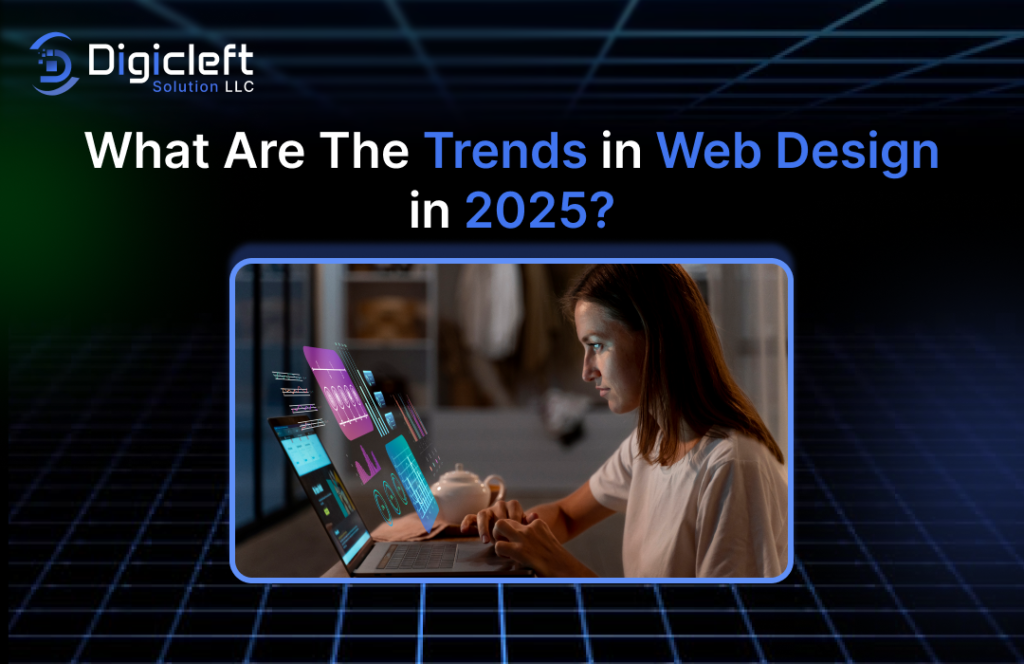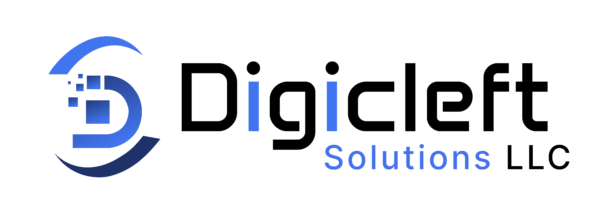
Overview:
In today’s ever-evolving digital world, web design is no longer just about aesthetics—it’s about experiences. As we step deeper into 2025, the landscape of web design is undergoing a remarkable transformation. The rise of artificial intelligence, immersive technologies, and user-centric philosophies is setting new benchmarks for what makes a website not just look good, but feel right.
At Digicleft Solutions, we always stay ahead of the curve in innovation. In this article, we’ll explore the top web design trends of 2025 that are reshaping the way users interact with the digital world—and how your business can stay ahead of the curve.
AI-Driven Personalization: Beyond Static Design
Artificial Intelligence (AI) is no longer a buzzword—it’s a necessity. In 2025, websites will leverage AI to dynamically adapt content, design elements, and user journeys based on individual behavior and preferences.
Key applications:
- AI chatbots that remember past interactions
- Predictive product suggestions
- Personalized layouts and dashboards
- Real-time behavioral adaptation
Why does it matter:
Visitors want relevance, not randomness. AI empowers websites to deliver personalized experiences that convert better and retain longer.
Dark Mode and Light Mode Toggles
Dark mode isn’t going anywhere—and 2025 brings even more customization. Many websites now offer auto-switching themes that adjust according to the user’s device, location, or even the time of day.
Why is it trending?
- Reduces eye strain
- Saves device battery
- Enhances readability at night
- Looks modern and elegant
Add a light/dark toggle switch to let users choose their preferred viewing mode—bonus points for animations.
Bold Typography and Kinetic Fonts
Typography has evolved from being just a design component to a statement piece. In 2025, we’re seeing kinetic typography—animated, interactive fonts that grab attention and drive engagement.
Trends within this trend:
- Oversized, bold headlines
- Interactive or scroll-triggered text effects
- Custom serif and sans-serif typefaces
- Emotion-driven font choices
Why is it effective?
Kinetic fonts offer a strong emotional impact and help guide users through your story, making content memorable and dynamic.
Mobile-First, Then Desktop
It’s official: mobile traffic will dominate the web in 2025. The new design mantra? “Design for thumbs first.”
Mobile-first trends include:
- Vertical scrolling experiences
- Tap-friendly buttons
- Collapsible content for better navigation
- Lazy loading and minimal bloat for faster loading
If your site doesn’t perform flawlessly on mobile, you’re already behind.
Neuro design: Tapping into the Brain
Neurodesign is an emerging trend that blends psychology, neuroscience, and UX/UI design to create intuitive and emotionally resonant experiences.
Examples:
- Using color psychology to influence user behavior
- Designing with cognitive load in mind
- Emotionally intelligent micro-interactions
- Visual storytelling that evokes empathy
Why it’s important:
Design isn’t just what users see—it’s how it makes them feel. Neurodesign makes websites irresistibly engaging by aligning with how the brain naturally processes information.
Immersive 3D and Interactive Elements
Thanks to WebGL, Three.js, and enhanced browser support, 2025 is seeing a surge in real-time 3D content, animations, and scroll-based interactivity.
Trending implementations:
- Parallax 3D scrolling
- Interactive product demos
- Realistic virtual showrooms
- 360-degree tour integrations
Why it matters:
Interactivity boosts session time, click-through rates, and conversions. A 3D experience can turn passive browsing into active exploration.
Micro Animations & Scroll-Triggered Motion
Micro animations—small, subtle movements triggered by user interactions—are more prominent than ever. They guide users, offer feedback, and create a more delightful experience.
New in 2025:
- Scroll-triggered storytelling animations
- Hover and click animations with a purpose
- UI responses that mimic real-world physics
Don’t overdo it—smooth, intentional animation is key. Too much movement can feel chaotic.
Brutalism Meets Minimalism
Designers in 2025 are finding a middle ground between raw, edgy brutalism and clean, user-focused minimalism. This hybrid style delivers high impact without overwhelming users.
What this looks like:
- Grid-breaking layouts
- Flat backgrounds with bold color blocks
- Monochrome palettes with one accent color
- Deliberate “ugly-beautiful” elements
Why it’s popular:
It feels modern, disruptive, and memorable, especially for startups and creative brands.
Accessibility-First Design
Accessibility is no longer optional—it’s standard practice. In 2025, web designers are creating websites that are inclusive from the ground up.
Design features include:
- Voice navigation compatibility
- High-contrast color modes
- Keyboard-only navigation
- Alt text automation via AI
Accessibility is not just about compliance—it’s about respecting and empowering all users.
Privacy-Centered UX
In the post-cookie era, user trust is everything. Websites are being designed to be transparent, secure, and respectful of data privacy.
UX trends focused on privacy:
- Clear cookie consent banners
- Easy-to-read privacy policies
- Opt-in design patterns
- Data dashboards for user control
Why it matters:
Privacy is a competitive advantage. Users trust brands that protect them, and design plays a crucial role in that communication.
Generative and Modular Design Systems
With AI-assisted tools and component-based frameworks like Figma, Tailwind, and Framer, 2025 is poised to be all about building scalable design systems.
Emerging standards:
- Token-based design libraries
- Modular UI kits for rapid prototyping
- Design-to-code automation
- Real-time collaboration in cloud design tools
Why it’s big:
These systems accelerate design workflows, ensure brand consistency, and facilitate A/B testing with ease.
Data Storytelling & Visual Intelligence
Data is powerful—but only when it’s easy to digest. Websites in 2025 use visual storytelling techniques to present complex data clearly and compellingly.
Key design techniques:
- Interactive infographics
- Scroll-based data reveal
- Dashboard-style landing pages
- Infused storytelling using charts and animations
Why it works:
Visual data builds credibility and makes even technical information relatable and shareable.
Conclusion:
Web design in 2025 is the perfect fusion of intuitive user experience, bold creativity, and intelligent technology. It’s no longer about static pages; it’s about living, breathing digital experiences.
At Digicleft Solutions, we don’t just follow trends—we shape them. Whether you’re redesigning your website or building one from scratch, our expert team is ready to future-proof your digital presence.
Let Digicleft Solutions help you ride the wave of design innovation. Our experts are ready to turn trends into results for your business.
FAQs –
How will web design evolve in 2025?
AI-driven personalization is the biggest trend. Websites that adapt to each user’s preferences, behavior, and context are leading the way in engagement and conversions.
Is dark mode still relevant in 2025?
Yes, and it’s become more customizable. Many sites offer light/dark mode toggles or even auto-switching based on user settings or time of day.
Are 3D elements practical for all websites?
Not always. While immersive 3D is ideal for products, portfolios, or creative brands, it should be used judiciously to avoid performance issues.
What role does accessibility play in modern web design?
A critical one. Accessible design ensures inclusivity for all users, improves SEO, and aligns with legal and ethical standards.
How do I keep my website up-to-date with these trends?
Partner with an agency like Digicleft Solutions. We monitor trends, analyze your user base, and apply the right strategies to grow your digital impact.
Should startups invest in cutting-edge web design trends?
Yes, but wisely. Focus on trends that improve usability and conversion, not just aesthetics. Choose what supports your business goals.
Can AI design websites completely by 2025?
AI can assist in layout, content, and personalization, but human creativity and strategic thinking are still essential for successful design.
What tools will be popular among designers in 2025?
Figma, Framer, Webflow, Adobe XD, and tools integrated with AI (like Uizard or Galileo AI) are dominating the design stack this year.


